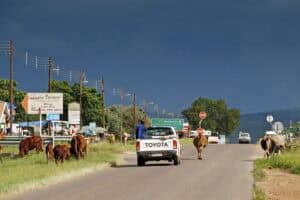The only region immune to this is much of the Western Cape, where local municipalities largely still function as they should.

There’s a disturbing trend playing out in small town South Africa, especially in those that still have a semblance of a middle-class population (many, many simply don’t). Entire parallel ‘municipalities’, in everything but name, are being set up by volunteers.
ALSO READ: SA’s local government service delivery failures and how to fix them
Beyond water and electricity, these entities now exist to fill the gap in providing fairly basic services. And to sustain this, residents – who are already paying property rates and fees for other services (think refuse collection) each month – need to stump up. It’s either that or watch their immediate surroundings descend into utter squalor.
This tends to begin with a residents’ association (or similar) ‘offering’ to trim all the verges on the main road through town ahead of the tourist season, or to paint a road marking or two where there no longer are any. Without this assistance, nothing will get done as the local municipality is practically dysfunctional (at best) or bankrupt and under administration (at worst).
This trend is particularly prevalent in very small holiday towns (villages, even) dotted along the country’s coastline. Think Kei Mouth, not Ballito.
ALSO READ: Municipalities’ Eskom debt escalates to R70 billion
The only region immune to this is much of the Western Cape, where local municipalities largely still function as they should. Some, however, remain dysfunctional. Just ask the residents of Knysna!
Larger metropoles not immune
To some extent, this is also happening in larger cities and metropoles where suburban residents’ associations are forced to bridge the service delivery gap.
ALSO READ: Time to punish municipalities for poor budgeting – Outa
In the Joburg context, these would’ve begun as security-focused entities, but many are taking on more and more ‘responsibility’ (reluctantly so), such as pothole repair, maintenance of parks and shared spaces, provision of solar lighting, and so on.
The worst is the ‘missing middle’, where local municipalities are barely functional but are too large for a residents’ association to fill the gap. Getting buy-in (financial and otherwise) from a few hundred houses isn’t hard. But beyond that, this becomes like wrangling a herd of cattle.
Fast forward, and suddenly, these associations are providing the majority of the services that municipalities ought to be, bar the provision of water and electricity – and collapsing infrastructure means even these are often unreliable.
When refuse removal becomes erratic due to the “non-availability of trucks” (a famous excuse), residents have to step in. Anything beyond electricity and water/sanitation is a ‘nice to have’, something that municipalities just don’t deliver.
Beach maintenance, parks and verges, paving, planting of trees, road markings, repairing of potholes, signage, public lighting, and even lifeguard equipment (!) are being provided by residents’ groups.
ALSO READ: Outstanding: Rand Water owed huge amounts by errant municipalities
Most of these entities are highly organised and efficient at delivery. Committee members have various portfolios, much like an actual municipality, and sometimes, this even extends into arenas such as safety and security, where relationships with the police and private security companies are established and maintained.
Price to pay
But this comes at a cost. Typically, residents pay an annual ‘levy’. This could be a few hundred or a few thousand rands (easily R3 000 in certain cases), depending on the size of the community, town or village. The larger businesses in these towns are typically outsized contributors to these kinds of associations (through time, money, space, labour and so on).
It’s obvious that these entities are very effective – they have an incentive to be! Don’t deliver, thereby no longer adding any value, and residents will simply stop contributing.
The fundamental question is how long homeowners will tolerate paying twice (or at least a ‘premium’) for the same services.
ALSO READ: CoGTA deploys experts to dysfunctional municipalities amid debt, governance challenges
Property rates are not exactly cheap (and easily in line with the tariffs levied in larger towns and cities). An owner of a house valued at R2 million will be paying close to R20 000 a year in property rates. Adding a thousand or two to that figure is material, especially as roads crumble and basic maintenance on public spaces is seldom done (if ever).
Homeowners know they can’t afford not to pay these private volunteer-led entities to maintain public spaces and keep these small towns ‘liveable’.
At what point do rate boycotts in these small towns become a reality?
This article was republished from Moneyweb. Read the original here






